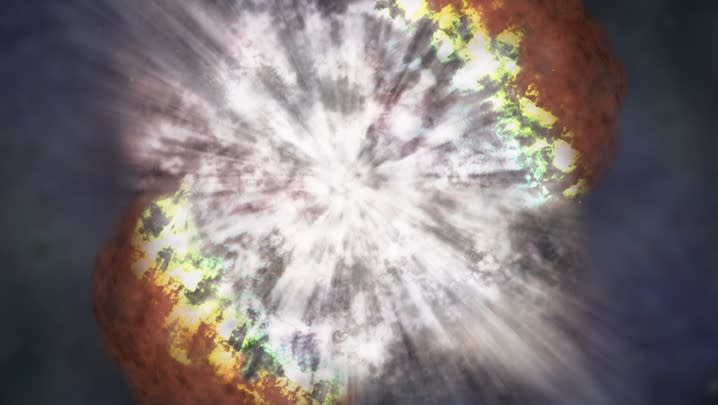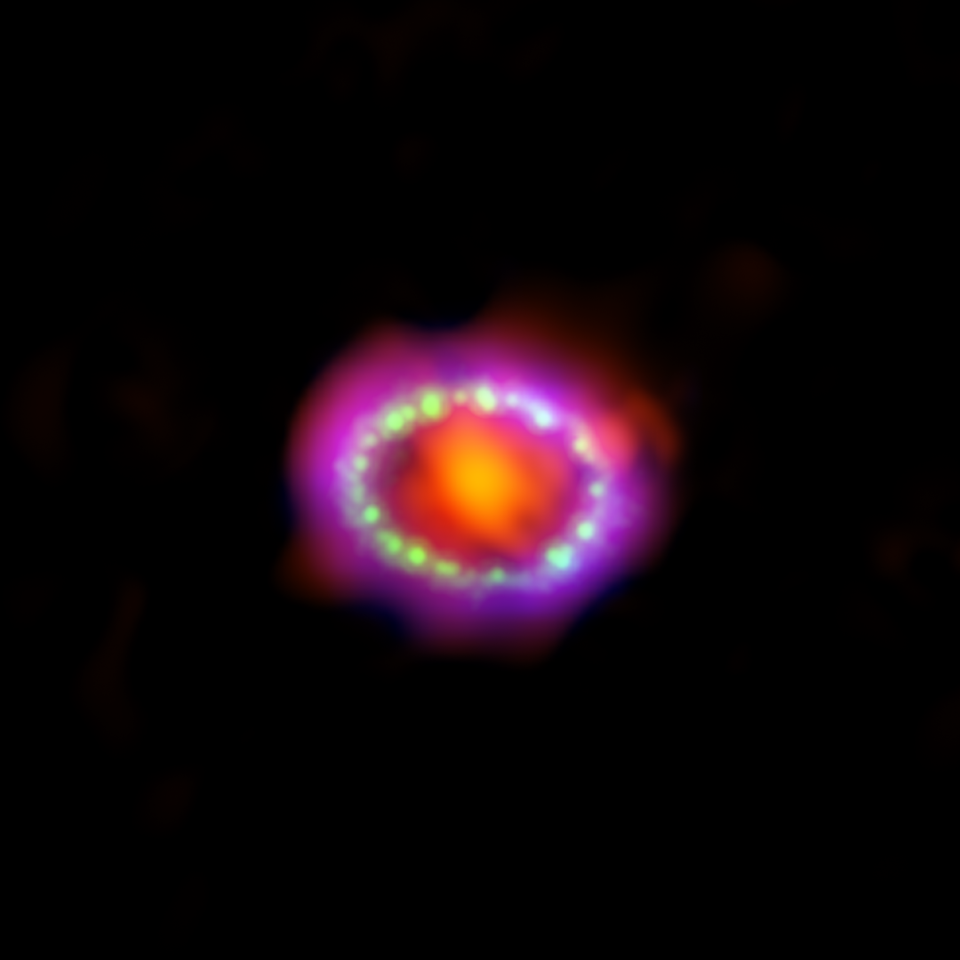A nearby supernova could reveal the secret lives of ghostly neutrinos. Here's how.

Physicists have made a leap forward in understanding how ghostly particles called neutrinos might interact with each other, by modeling how neutrinos escaping into space from exploding stars flow like a high-speed liquid.
Such interactions between neutrinos could have implications for understanding the Big Bang as well as physics beyond the Standard Model. However, to confirm how these elusive interactions take place, astronomers will need to wait for the next supernova in our Milky Way galaxy.
Of all the particles in the Standard Model of physics, neutrinos are the ones scientists know the least about. They have very tiny masses, barely interact with normal matter, can spontaneously change identity from one type of neutrino to another and are ubiquitous throughout the universe — there are trillions of neutrinos passing through your body right now.
Related: Scientists find 'ghost particles' spewing from our Milky Way galaxy in landmark discovery (video)
Neutrinos are also difficult to detect. It would take a bar of lead a light-year long to stop just half of the neutrinos that pass through you. They interact with matter so infrequently that the world’s leading neutrino detector, the IceCube Neutrino Observatory at the South Pole, detects just 275 neutrinos on average per day.
Sometimes, though, there’s an upsurge in neutrinos — for example, from a nearby supernova. The closest observed supernova in over 400 years was SN 1987A, in the Large Magellanic Cloud, a satellite galaxy of our Milky Way. It is estimated to have produced an incredible 10^58 neutrinos, but detectors on Earth only observed 25 of them. Nevertheless, researchers from Ohio State University have now harnessed those 25 detections to investigate the mysterious possibility that neutrinos are able to interact with each other.
According to the Standard Model, neutrinos should be able to interact with each other. Such interactions could have huge consequences, helping to explain, among other things, the origin of the masses of neutrinos, why there are so many neutrinos in the universe, how they might leave an imprint on the cosmic microwave background (CMB) radiation from the Big Bang, why the universe is lacking antimatter and even how neutrinos might have assisted in the formation of dark matter in the early universe. This connection comes from a neutrino’s ability to oscillate into different flavors — usually either electron, lepton and tau neutrinos, but a fourth form of neutrino referred to as a sterile neutrino has also been postulated. The sterile neutrino is one possible candidate for the identity of dark matter. However, so far no experimental evidence for sterile neutrinos has come to light.

To better understand these neutrino self-interactions, the Ohio State team, led by astrophysicist Po-Wen Chang, modeled how the neutrino signal from SN 1987A would appear based on relativistic hydrodynamics, which describes how particles that are tightly coupled together and act like a liquid behave when moving at close to the speed of light, which neutrinos do. Acting as a kind of quasi-liquid in this way would enable the neutrinos to interact with each other.
Under relativistic hydrodynamics, the neutrinos could "flow" from a supernova in one of two ways. The first is as a "burst outflow," which is analogous to popping a balloon in space and the resulting energy pushing out in all directions. The second — and thought to be more likely — possibility is as a "wind outflow," which imagines that the energy escapes from the popping balloon via myriad nozzles, which would produce a more consistent flow rate of neutrinos. Each type of outflow would produce its own distinct pattern in the neutrino signal from a supernova. However, Chang’s team found that the paucity of neutrinos detected from SN 1987A isn’t enough to rule either mechanism out yet.
"The dynamics of supernovae are complicated, but this result is promising because with relativistic hydrodynamics we know there’s a fork in the road in understanding how they work now," Po-Wen Chang said in a statement.
RELATED STORIES:
— 'Neutrino factories' could hold the solution to the cosmic ray mystery
— 'Ghost particle' coming into focus: Scientists put upper limit on mass of neutrinos
— Large Hadron Collider experiment investigates neutrino's minuscule mass
The team stressed that their work is a big step forward in understanding how neutrinos scatter from an exploding star. Once the exact mechanism has been identified, physicists will have a better idea of how neutrinos can interact with each other. To accomplish this, new data will be required from another nearby supernova, from which the neutrinos could be tested for both the burst and wind flow mechanisms. The problem is, a visible supernova in the Milky Way galaxy or one of its satellite neighbors is a rare thing indeed.
"We’re always praying for another galactic supernova to happen somewhere and soon, but the best we can do is try to build on what we know as much as possible before it happens," said Chang.
Neutrino interactions are also seen as a gateway to new physics beyond the Standard Model. Stretching our knowledge of physics into revolutionary new areas is important for physicists who are looking to explain many of cosmology’s greatest mysteries, including dark matter, dark energy, the tension in measurements of the expansion of the universe and the fundamental nature of matter and space-time.
The team's results were published this week in the journal Physical Review Letters

